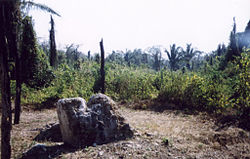Motul de San José

A badly fire-damaged stela in Group C
|
|
| Location | San José |
|---|---|
| Region |
Petén Department, |
| Coordinates | 17°1′35″N 89°54′5″W / 17.02639°N 89.90139°W |
| History | |
| Periods | Middle Preclassic to Early Postclassic |
| Cultures | Maya |
| Site notes | |
| Excavation dates | 1998–2008 |
| Archaeologists |
Antonia Foias, Kitty Emery Proyecto Arqueológico Motul de San José |
| Architecture | |
| Architectural styles | Classic Maya |
Antonia Foias, Kitty Emery
Motul de San José is an ancient Maya site located just north of Lake Petén Itzá in the Petén Basin region of the southern Maya lowlands. It is a few kilometres from the modern village of San José, in Guatemala's northern department of Petén. A medium-sized civic-ceremonial centre, it was an important political and economic centre during the Late Classic period (AD 650–950).
The site was first settled between 600 and 300 BC, in the latter portion of the Middle Preclassic period, when it most likely was a fairly small site. This Maya city then had a long and continuous occupational history until the Early Postclassic, up to around AD 1250, with peaks in the Late Preclassic and Late Classic periods. Motul de San José had begun to refer to Tikal as its overlord in the late 4th century AD; by the 7th century it had switched its allegiance to Calakmul, Tikal's great rival, before returning its allegiance to Tikal in the early 8th century. In the late 8th century Motul de San José appears to have been conquered by Dos Pilas, capital of the Petexbatún kingdom.
Most natural resources were easily available in the immediate vicinity of the city. The nearby port at La Trinidad de Nosotros was an important hub for the import of exotic goods and export of local products such as chert and ceramics. Other goods not immediately available were likely to have been provided by the city’s satellite sites. The local area provided a number of different soils suitable for varied agricultural use, and the port at La Trinidad de Nosotros provided the city with freshwater products such as turtles, crocodiles and freshwater molluscs. Deer were hunted locally and provided an important source of protein for the upper class, while freshwater snails were the main source of protein for commoners.
...
Wikipedia

